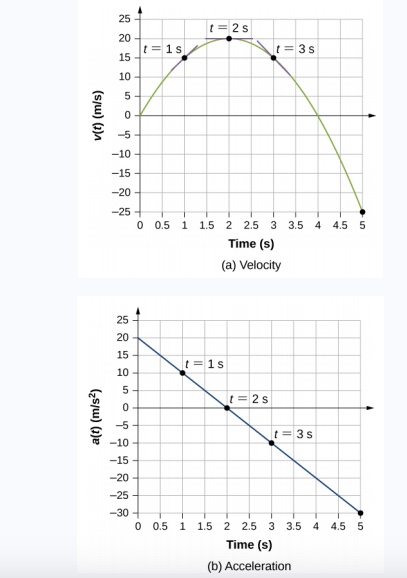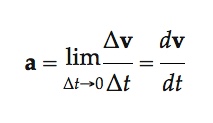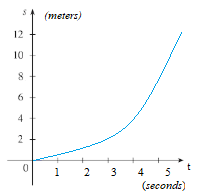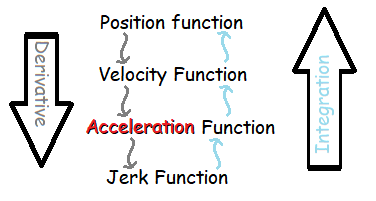
Acceleration is a measure how the velocity of an object changes. In calculus, you can find it using derivatives.
Contents (Click to skip to that section):
Acceleration is an important concept in physics: it’s the rate of change in velocity over time. In other words, it tells you how much the velocity iscreasing, or decreasing. Is the object speeding up? Slowing down? Moving at a constant speed in a straight line? If you’ve ever been in a moving elevator, you’ve probably felt the effects of acceleration: an elevator that’s accelerating pushes you to the floor, and one that’s decelerating makes you feel a little weightless.
Constant Acceleration
Constant acceleration is when the velocity changes at a constant rate.
Example: Imagine you toss a beanbag into the air. The bag rises into the air, coming to a halt at the top of its path. Then, it rapidly begins to descend until it falls into the palm of your hand. Other Gravity-related examples are easy to imagine: a truck rolling down a hill, or an apple falling from a tree.
Examples
When an object is at rest, its acceleration is constant (and equal to zero). This is true because its position does not change, so its velocity is zero at all times.
x(t) = 0
v(t) = x′(t) = 0
a(t) = v′(t) = 0
Even if the velocity is allowed to change, acceleration can still be constant. However, it must change at a steady rate.
The equations that describe an object in motion due to constant acceleration are called kinematic equations. The four kinematic equations are as follows:
Δx = vi t + ½ at2
Δx = ½ (vf + vi) t
vf2 = vi2 + 2aΔx
vf = vi + at
where:
- t: time (seconds)
- Δx: change in position (meters)
- vi: initial velocity (meters per second)
- vf: final velocity (meters per second)
- a: acceleration (meters per second squared)
Example question: If you drop a baseball off of the grand canyon, how long will it take for the baseball to travel 100 meters?
In this case, acceleration is 9.8 meters per second squared, while the change in position is 100 meters. Because the ball is dropped from rest, the initial velocity is zero. Knowing these variables, we can use equation #1 to solve for time.
Δx = vi t + ½ at2
100 = 0 + ½ (9.8) t2
20.408 = t2
t = 4.52 seconds
Constant acceleration is sometimes difficult to conceptualize, but hopefully, this article has offered some real-world examples that make the idea more concrete.
1. Gravity

The most common situation characterized by constant acceleration is an object being pulled by gravity. Gravity is a relatively constant force near a planet’s surface, meaning that it exerts a constant acceleration on all objects. For instance, the value of gravity’s acceleration on Earth is 9.8 m/s2.
2. Friction
Another frequent instance of constant acceleration is a body decelerating in the presence of friction. Friction is directly proportional to the weight of an object, and so it will remain constant over time. Remember from our gravity example that a constant force implies a constant acceleration.
Friction-related examples are a bit more challenging to visualize, but some common scenarios include:
- A bowling ball rolling down an alley,
- An ice skater gliding to a stop.

Instantaneous Acceleration
In Calculus, instantaneous acceleration is the acceleration of an object at a specific moment in time. It’s the rate that the object changes it’s velocity.
As an example, let’s say a car changes its velocity from one minute to the next—perhaps from 4 meters per second at t = 4 to 5 meters per second at t = 5, then you can say that the car is accelerating. The SI unit for a is meters per second squared (m/s2.
Zero and Uniform
An object that is simply moving fast at a constant rate (e.g. 60 mph) is not accelerating—and has an instantaneous acceleration of zero. For example, let’s suppose a car is traveling at the following velocity:
- 60 m/s at t = 10 seconds,
- 60 m/s at t = 11 seconds,
- 60 m/s at t = 12 seconds.
Although the car is moving, it’s velocity doesn’t change from 60 m/s; It has zero acceleration. That could also mean that the velocity is at a maximum or minimum value.
This is not to be confused with constant acceleration (sometimes called uniform), where it accelerates at a constant rate. For example, let’s say a car is traveling at:
- 10 m/s at t = 10 seconds,
- 15 m/s at t = 11 seconds,
- 20 m/s at t = 12 seconds.
For each change in time of one minute, the car increases its velocity by 5 m/s. The car has constant acceleration of 5 m/s2.
A Graphic Look
If you graphed velocity as a function of time, instantaneous acceleration would be the slope of the tangent line.
What this means is that if the velocity function is a straight line, the instantaneous acceleration will be constant (the tangent will always be a straight line).

If the instantaneous acceleration changes, the velocity is that of a curve.

A negative instantaneous acceleration means the velocity is decreasing. If it is positive, our velocity is increasing.
Using Calculus to Find Acceleration
Acceleration is measured as the change in velocity over change in time (ΔV/Δt), where Δ is shorthand for “change in”. For example, let’s calculate a using the example for constant a above. The velocity at t = 10 is 10 m/s and the velocity at t = 11 is 15 m/s. The average acceleration would be:
Change in velocity / change in time = (15 m/s – 10 m/s)/(11 – 10) = 5/1 = 5 m/s2 .
You can’t calculate instantaneous acceleration in quite the same way because you don’t have a start time and an end time. Instead, imagine you are finding the same quotient—the difference in velocity over difference in time—over an infinitely small time period. You can write this as:

In English, that’s saying that a is the derivative of velocity (dv/dt).
To get the acceleration of an object in calculus, we must take the derivative of its velocity with respect to time:
a(t) = v′(t)
We can also think about acceleration in terms of an object’s position. Since velocity represents a change in position over time, then acceleration would be the second derivative of position with respect to time:
a(t) = x′′(t)


If you’re given a function and asked to find a, follow the diagram above to figure out what you need to do. For example,
- If you have a velocity function, the diagram shows that a is one step down from velocity. And the down arrow shows “Derivatives”. Therefore, take the first derivative to find a. “Take the first derivative” just means to take the derivative one time.
- If you are given a position function (i.e. the position of an object over time), you’re two steps away, so take the second derivative to find a.
You can also work backwards to find a. When I say “backwards” here, I’m talking about integrals, which is basically “undoing” the derivative. If you are given a jerk (the third derivative of the position function), you’ll want to integrate once.
2. Example with Steps
Note: You can find “a” when given either:
- a function of the distance an object travels over time, or
- a function of an object’s velocity over time.
If you are given distance, start at Step 1. If you are given the velocity, skip ahead to Step 3.
Step 1: Set up your equation. Given a function for the distance an object travels over time, set the derivative of the function with respect to time as equal to the velocity of the object. For example:
![]()
The notation “d/dt” is for the derivative. I could just have easily used D or some other notation.
Splitting up the summands (to make differentiation easier), the equation changes to:
![]()
Step 2: Solve for velocity by performing the differentiation. There are several ways to do this, depending on what the format of your function is. This particular function calls for the Power Rule:

Step 3: Find the derivative again (you’re basically finding the second derivative of the position function here).
![]()
This means the acceleration of the object has a constant value of 2.
Tip: When there are leftover variables in the formula, this means the acceleration is not constant over time. Be sure to include any units of measure in your answer to make it correct.
References
Ling, Sanny, & Moebs. Average and Instant. Acceleration. OpenStax University Physics. Retrieved from
https://phys.libretexts.org/TextBooks_and_TextMaps/University_Physics/Book%3A_University_Physics_(OpenStax)/Map%3A_University_Physics_I_-_Mechanics%2C_Sound%2C_Oscillations%2C_and_Waves_(OpenStax)/3%3A_Motion_Along_a_Straight_Line/3.3%3A_Average_and_Instantaneous_Acceleration on October 7, 2018
Stoner, Ron. Instant. Acceleration. Retrieved from http://physics.bgsu.edu/~stoner/p201/kin2d/sld008.htm on October 7, 2018
Bowling ball image: Orderinchaos | Wikimedia Commons. CC-Sharealike.